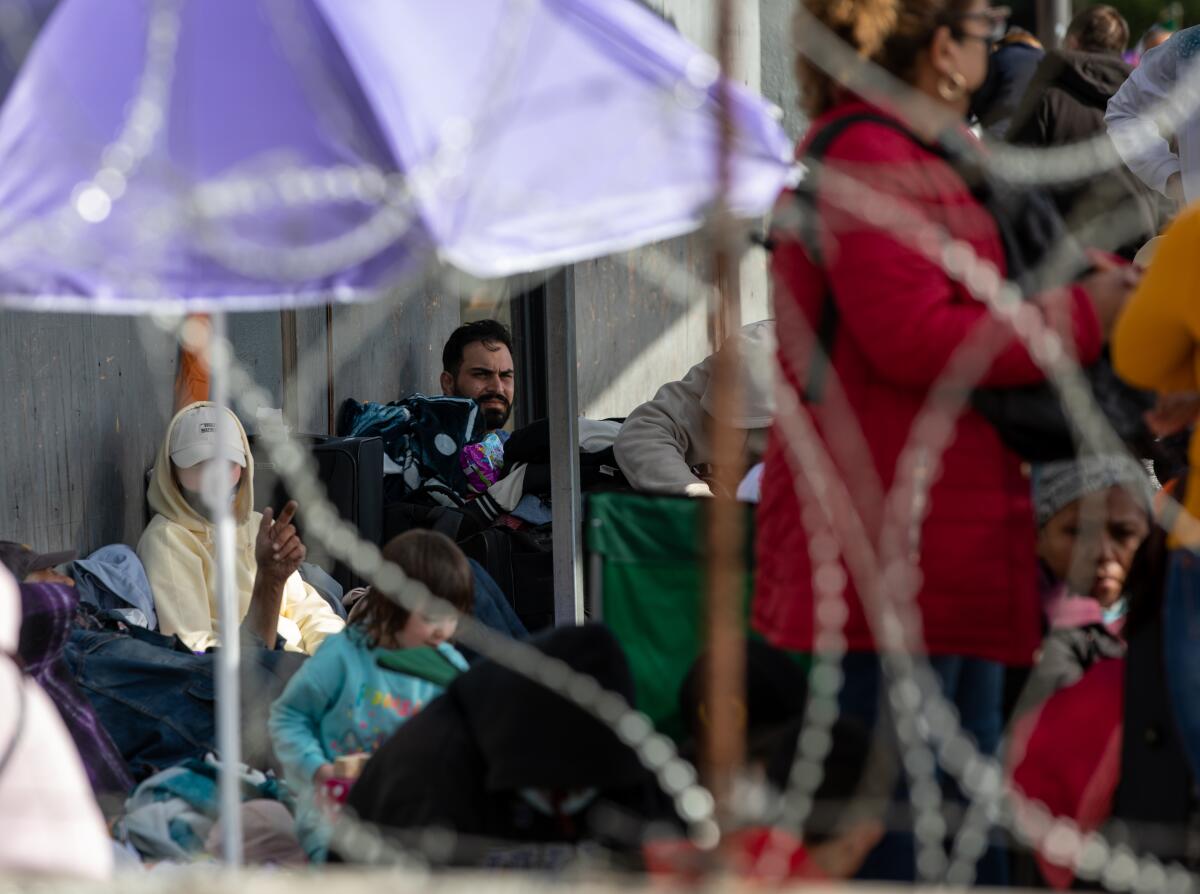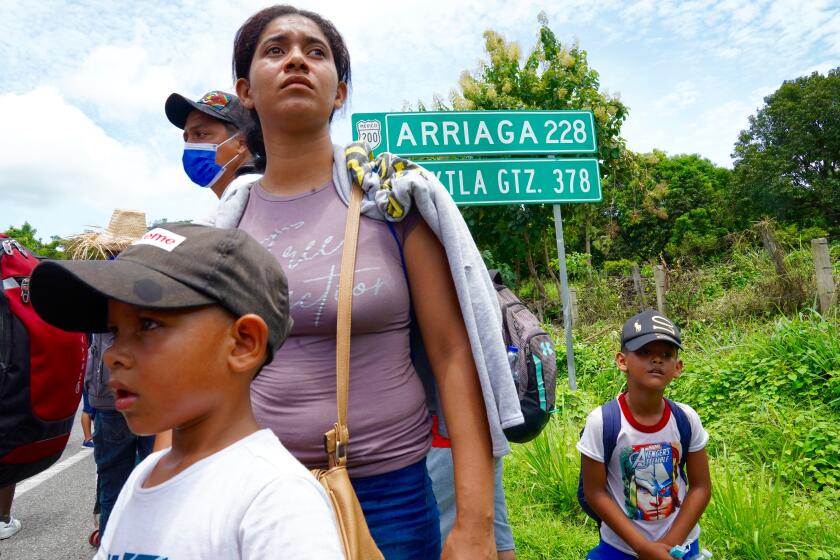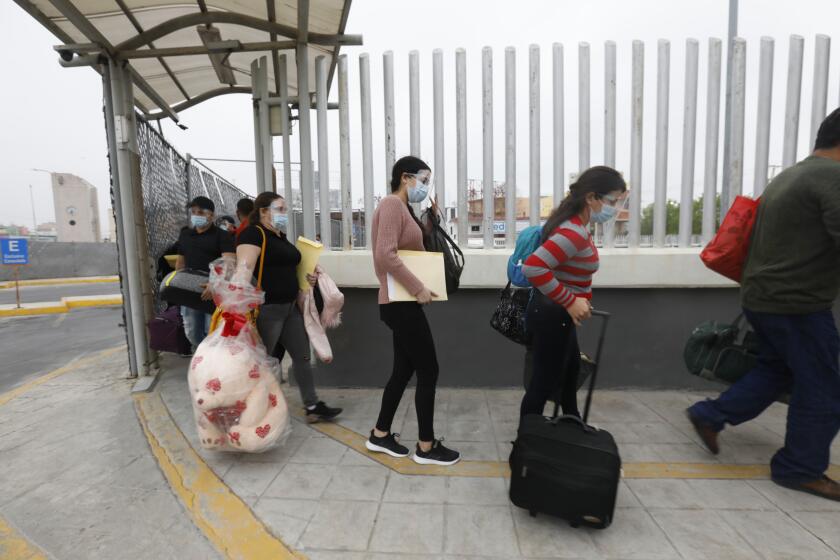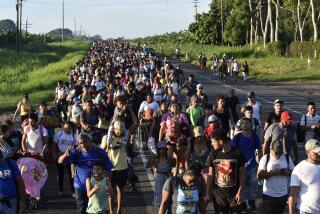CDC says controversial border policy keeping out asylum seekers will end in May

- Share via
The U.S. Centers for Disease Control and Prevention has moved to end a controversial border policy that kept thousands of asylum seekers from requesting protection in the United States over the last two years.
The decision Friday leaves the policy, known widely as Title 42, in place until May 23.
Enacted in March 2020 by the Trump administration, the policy says that border officials can prevent asylum seekers and other undocumented migrants from crossing onto U.S. soil and expel them if they do manage to get inside the country. Those expulsions sent many back to the country they crossed from — generally Mexico — or to their countries of origin without screening them for protection needs as usually required under U.S. law and international treaties.
“After considering current public health conditions and an increased availability of tools to fight COVID-19 (such as highly effective vaccines and therapeutics), the CDC Director has determined that an Order suspending the right to introduce migrants into the United States is no longer necessary,” the CDC said in announcing the forthcoming change.
The CDC noted that it will guide the Department of Homeland Security on “additional COVID-19 mitigation procedures.”
Title 42 is a public health policy that’s being used to determine whether immigrants can cross the border. Here’s how it works.
Both the Trump and Biden administrations defended the Title 42 policy, arguing that it was necessary to slow the spread of COVID-19. Critics have said the policy, which invokes a 1944 public health law, is based on a xenophobic falsehood that migrants are somehow more likely to have diseases than other people and argued that it was a restrictionist mechanism meant to keep migrants out of the U.S. altogether.
Public health experts and federal judges alike have questioned the need for the program.
For asylum seekers affected by Title 42, the policy has meant being sent back to places where they are likely targets for violent attacks and kidnappings, or even back to the places and people they fled in the first place.
Title 42 hasn’t affected all asylum seekers evenly. Some nationalities have been processed into the United States despite the policy while others continued to be turned away.
That disparity grew more visible as the United States began exempting Ukrainians who arrived at the San Diego-Tijuana border and allowing them to walk into the San Ysidro Port of Entry to request protection while border officials still turned away Mexican asylum seekers who said the people trying to kill them were searching for them in Tijuana.
After several news organizations reported that the CDC had drafted a decision to end Title 42 earlier this week, asylum seekers waiting in Tijuana for the possibility of asking the United States for protection reacted with a mixture of relief and frustration.
Brigitte, a 35-year-old seeking asylum from Mexico who has been living in a shelter in Tijuana for roughly seven months, said she was excited about the possibility of finally being able to request asylum.
“It’s been really difficult for me,” said the woman, who is transgender. Like other asylum seekers, she asked not to have her full name used out of safety concerns. “As everybody knows, us transgender women in Mexico, we get discriminated a lot. It makes me really happy that the officials are finally doing something to end Title 42. It makes me dream about a better future for me and my family.”
Breaking News
Get breaking news, investigations, analysis and more signature journalism from the Los Angeles Times in your inbox.
You may occasionally receive promotional content from the Los Angeles Times.
Vanessa, a Honduran mother who lived in a tent camp outside a port of entry in Tijuana until Mexican officials bulldozed it in February, called the announcement “a miracle from God.” Since the camp shut down, she’s been struggling to pay rising rents on a crumbling apartment whose kitchen is full of mold but lacks a refrigerator and stove in a neighborhood where her son has already been threatened.
Another woman from Honduras who lived in the tent camp said that she hopes to finally reunite with her children, who fled before her because gangs tried to get them to join and sell drugs. When the gangs realized that her children were gone, they came after her, and she, too, had to leave.
Maria, who also lived in the camp, has been trying to figure out how to sneak into the United States for the last month. She often messaged the San Diego Union-Tribune to ask about updates on Title 42 when she heard rumors that it would end soon.
“It’s taken too long,” Maria said. “Because of this title, children are dying in the river and desert, as well as adults. It’s not because they want to but because of desperation for each and every one of these people.”
Some hesitated to comment on the draft plans, not believing them to be real.
It’s not yet clear exactly how the Biden administration will begin to process the thousands of people who have been waiting months and years to ask the United States for protection.
Asylum seekers who arrived at the border before the pandemic were generally placed in a process called “expedited removal” and given preliminary interviews by asylum officers to see if they should be further screened by immigration judges or deported. If they moved on to the immigration court step, they might stay in immigration detention or be released into the United States.
In 2019, the Trump administration began requiring some asylum seekers to wait in Mexico for their U.S. immigration court hearings. That policy, known as the “Remain in Mexico” program, restarted in December 2021 after a court order from a lawsuit brought by the states of Texas and Missouri, affecting more than 1,500 people through the end of February.
The Biden administration recently published rules that will change asylum by speeding up processing at the border in hopes of alleviating immigration court backlogs. The overhaul is scheduled to take effect May 28 but will initially apply only to a small number of migrants, with capacity gradually increasing.
Fixing asylum, a process that can drag out for years, was one of President Biden’s promises as a candidate
The revamp worries many advocates, who say the new process fails the very people it seeks to protect because trauma survivors won’t have enough time to find a lawyer, gather evidence and recover by the time they have to make their case.
On Thursday, less than 24 hours before the announcement, a Haitian family — a mother, father and their three young daughters — were allowed into the San Ysidro Port of Entry to begin the process of requesting protection. With Title 42 in effect, that moment took months, and two teams of attorneys, to arrange.
“It’s been really terrible and sad for us here,” the mother, Landy, 29, said through a Creole interpreter. “Our daughter is very ill, so it’s been very hard.”
One of the daughters has a severe skin condition that could end up killing her if she’s not treated in time, and doctors in Mexico had been unable to help. In the meantime, the condition kept getting worse.
The family had been in Tijuana since December, living in shelters or on the street when no shelter was available.
Attorneys with Al Otro Lado filed a request to Customs and Border Protection, including a doctor’s letter asking to allow the family through a process called humanitarian parole because of the child’s urgent condition. It took a second request filed by attorneys with the Center for Gender and Refugee Studies and additional medical letters before the family’s request was approved.
They walked up to the San Ysidro Port of Entry shortly before their appointment time, but they ended up waiting nearly an hour as border officials alternated processing groups of Ukrainians fleeing war, agricultural workers with temporary visas and the general public.
How much Customs and Border Protection will prioritize asylum seekers in the wake of Title 42’s end remains unclear. A federal judge in San Diego ordered last year that the agency’s practices of “metering” asylum seekers, or turning away people seeking protection when they approach the border, is illegal.
The judge hasn’t yet ruled on a specific remedy, and, with Title 42 still in effect, the government hasn’t adjusted its practices on its own.
Los Angeles Times staff writer Andrea Castillo contributed to this report.
More to Read
Sign up for Essential California
The most important California stories and recommendations in your inbox every morning.
You may occasionally receive promotional content from the Los Angeles Times.













